No. 1 - Sprouting Radishes & Broad Beans
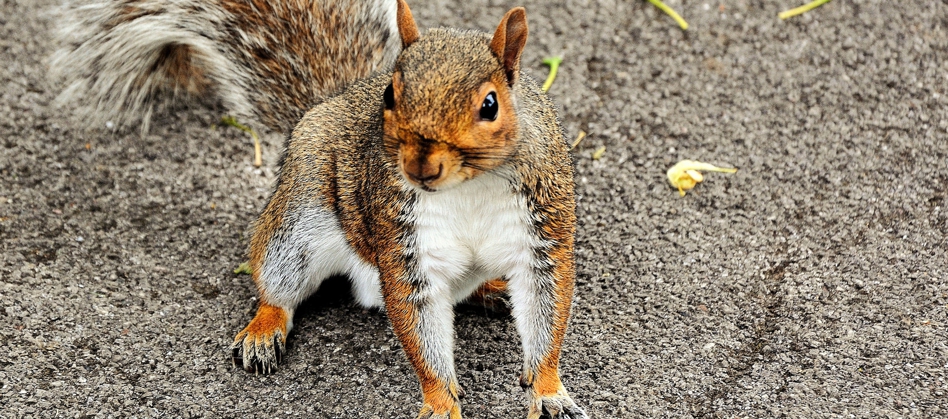
Developing Responsibility and Observation Skills
Introduction to Nature's Lesson Book
ENCOURAGES HOLISTIC DEVELOPMENT IN ALL
Activities for children and adults alike, which incorporate the things in the natural world, are most productive. The social, physical, emotional, intellectual and spiritual elements are enhanced in all parties if approached in the right way. This series suggests activities that can have a positive impact on relationships and attitudes. Some activities apply directly to children in their early years, but many adults will also find them interesting and enjoyable.
A DESIRE FOR SIMPLE PLEASURES DESTROYED
Development of knowledge and interests in a variety of natural disciplines, e.g. birds, shells, wildflowers or plants, enables the fortunate person to be amused and entertained where ever they go. Activities in nature are inexpensive. Unfortunately, many adults and children have very little interest in simple pleasures because of the negative influence of adrenalin pumping, media-oriented, entertainment. Parents need to lead the way in this area; usually, the things that amuse and excite parents are picked up on and taken on board, by the children. I understand that a change in amusement patterns is hard for some parents, especially if they have been developing these habits for decades. Self-sacrifice on the part of parents can reap huge returns in seeing changes for the better in their children.
A PARTIAL LIST OF THE BENEFITS OF NATURAL AMUSEMENTS
- A love of beauty
- An appreciation of, and respect for, the natural world
- Respect for life
- Enhanced creativity
- Enhanced fine and gross motor skills
- Improved observation skills
- An appreciation for the interdependence of living things
- Develop a wonder for the behaviour of animals and plants
- Find simple pleasures relaxing and entertaining
- An understanding that some things take a long time
- Appreciate the social benefits of like-minded people
- Develop the ability to share knowledge of the natural world with others
- Acquire knowledge and skills that could lead to life-long occupations
- An awareness of the passing of time
- Learn independence and survival skills
- Have an awareness of, and respect for, the dangers that abound in the natural world
Sprouting Radishes & Broad Beans
THE BENEFITS
- RESPONSIBILITY: Give children responsibility for buying seeds, setting up the activity, watering, observing and reporting evidence of growth.
OBSERVATION SKILLS: Encourage children to make regular observations. - COMMUNICATION SKILLS: Discuss the activities with the children. Ask them what you might need; what other seeds or plants they might be able to sprout; why the sprout died; what makes the plants grow: why the root always goes down; why some grow faster than others etc.
- RECORDING SKILLS: Recording activities could include the following: verbal recording on a mobile phone; graphing growth against time; daily written observations, with one, simple sentence, about something they observed; give an account to a parent when they come home from work.
- UNDERSTANDING DEPENDENCE: Assist children to appreciate the dependence of seeds and plants on water and light. Place batches of seeds in different locations, e.g. near the window, in a dark corner, in the fridge.
- PATIENCE AND COOPERATION: Waiting for seeds, cloves and vegetables to sprout develops patience. Some seeds, bulbs, cloves, etc. take quite a long time and some are seasonal so the wait time can run into months. It is advisable to have a mix of fast and slower sprouting plants so children can have something of interest to look at regularly.
Sprouting Radishes
NEEDED ITEMS
A shallow waterproof saucer or similar, cotton wool and radish seeds. N.B. Folded material or cotton wool pads could be substitutes for cotton wool.
THE SETUP
- Place a flattened piece of cotton wool into the saucer, shallow dish or jar lid.
- Pour water onto the cotton wool so that the water is just below the top of it.
- Place some radish seeds on top of the wet cotton wool, so there is a little space between the seeds.
- Place the saucer on a window sill or somewhere where there are light and warmth. Find a place where it will not be kicked or knocked over.
- Check the seeds twice a day.
- Ensure the cotton wool is kept very moist.
My Observations
Day 0I put two cotton wool pads on a glass saucer, then I wet them and placed my seeds on the wet cotton wool. |
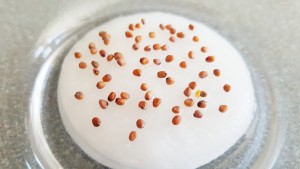 |
|||
Day 2I observe that a few of the seeds have begun to sprout. |
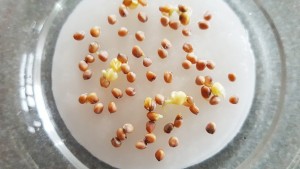 |
|||
Day 4Now nearly all the seeds have sprouted. |
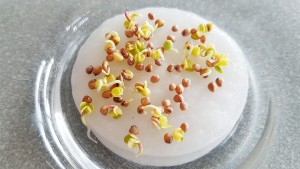 |
|||
Day 8Quite a few sprouts have grown taller, and the leaves are dark green. I notice that some of the seeds have not sprouted. |
 |
|||
Day 16More sprouts have grown and turned green, and some have grown tall. I can see that some seeds have sprouted, but they have not grown much. |
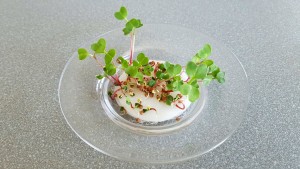 |
Sprouting Broad Beans
NEEDED ITEMS
A tall glass or jar, cotton wool, paper towelling, and broad bean seeds. N.B. Other substitutes for the paper towelling could be cut and folded material.
THE SETUP
- Place a folded and cut piece of paper towelling around the inside of a large glass.
- Pack cotton wool, not too firmly, in the middle of the paper towelling.
- Place some broad bean seeds between the glass and the paper towelling. I found a table knife was handy to make a gap for the seeds between the glass and the paper towelling.
- Pour water onto the cotton wool until the level of the water is a little under the seeds.
- Place the glass on a window sill or somewhere where there are light and warmth. Find a place where it will not be kicked or knocked over.
- Check the seeds twice a day.
- Ensure the cotton wool is kept very moist.
My Observations
Day 0I placed paper towelling around the inside of a large glass. I then packed cotton wool in the middle of the towelling. I then put the seeds around the outside of the paper towelling. Lastly, I poured water onto the cotton wool. |
 |
|||
Day 6I observe that the roots have started to grow and even though two seeds were upside down the roots turned downward. |
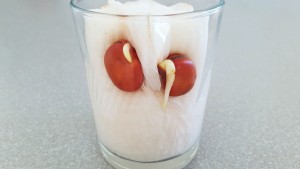 |
|||
Day 11The seeds are sprouting at different times. One seed now has a shoot with leaf buds. It also has laterals growing out of the primary root. |
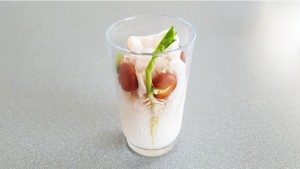 |
|||
Day 14Leaves have now emerged, and other seeds now have shot. The lateral roots are now thicker and getting intertwined with other roots. |
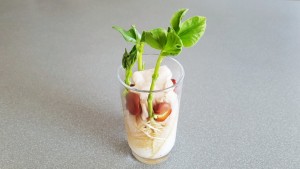 |
|||
Day 17Three shoots now have leaves, and they have grown up very tall. One shoot caught up with the one that came up first. |
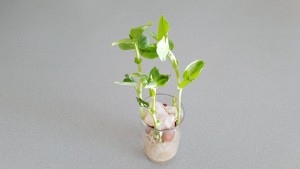 |
By
Richard Warden



